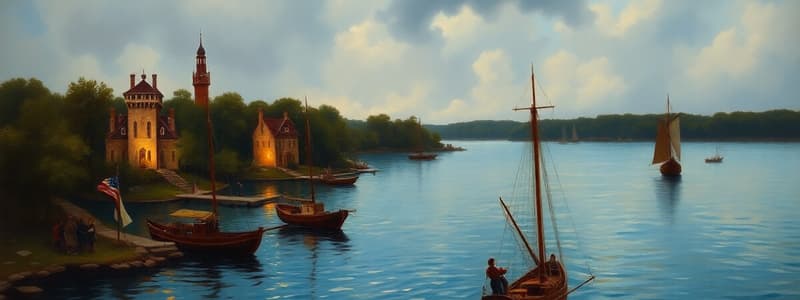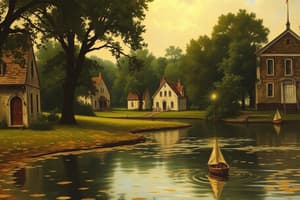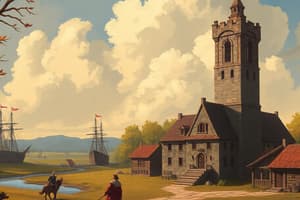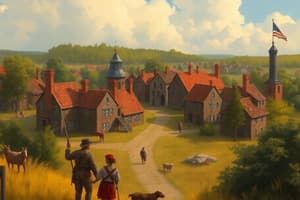Podcast
Questions and Answers
How did the governance structures of Virginia and Maryland diverge, despite their similarities?
How did the governance structures of Virginia and Maryland diverge, despite their similarities?
- Both colonies were royal colonies, but Virginia had a bicameral legislature, and Maryland had a unicameral one.
- Maryland operated under the direct control of the English king, whereas Virginia was a proprietary colony governed by the Calverts.
- Virginia's assembly was appointed by the Calverts, while Maryland's was elected by landowners.
- Virginia was a royal colony under the king's control, while Maryland was a proprietary colony controlled by the Calverts. (correct)
What was the long-term impact of the Toleration Act of 1649 on the religious landscape of Maryland?
What was the long-term impact of the Toleration Act of 1649 on the religious landscape of Maryland?
- It led to a period of religious harmony, with all faiths coexisting peacefully and sharing political power equally.
- It initially granted religious freedom to all Christians but was later repealed, establishing the Anglican Church as the official religion. (correct)
- It ensured the permanent separation of church and state, preventing any single denomination from gaining dominance.
- It established the Catholic Church as the official religion of Maryland, leading to the emigration of Protestants.
Cecilius Calvert's decision to appoint his brother Leonard as Maryland's first governor was most likely influenced by which consideration?
Cecilius Calvert's decision to appoint his brother Leonard as Maryland's first governor was most likely influenced by which consideration?
- A strategic move to ensure the colony's leadership was both trusted and aligned with the Calvert family's vision. (correct)
- A desire to emulate the political structure of Jamestown.
- A legal requirement stipulated by the King's charter for the Maryland Colony.
- A lack of qualified candidates willing to undertake the governorship in the new colony.
Considering the Calverts' objectives for the Maryland Colony, which factor would have most significantly contributed to its early success?
Considering the Calverts' objectives for the Maryland Colony, which factor would have most significantly contributed to its early success?
What inherent challenge in governing the Carolina Colony led to its division into North and South Carolina in 1712?
What inherent challenge in governing the Carolina Colony led to its division into North and South Carolina in 1712?
How did the introduction of rice cultivation impact the society and economy of South Carolina?
How did the introduction of rice cultivation impact the society and economy of South Carolina?
Considering the economic activities in Maryland and Virginia, what distinguished the experiences of most colonists from the wealthy plantation owners?
Considering the economic activities in Maryland and Virginia, what distinguished the experiences of most colonists from the wealthy plantation owners?
Considering typical colonial governance models, what was the most significant limitation on the free white male colonists' power in the Carolina Colony?
Considering typical colonial governance models, what was the most significant limitation on the free white male colonists' power in the Carolina Colony?
What was the primary reason why the Calverts chose to establish the Maryland Colony in North America?
What was the primary reason why the Calverts chose to establish the Maryland Colony in North America?
What economic impact did the geographical differences between North and South Carolina have on agricultural practices?
What economic impact did the geographical differences between North and South Carolina have on agricultural practices?
How did the experiences at Jamestown most directly influence the planning and establishment of the Maryland Colony?
How did the experiences at Jamestown most directly influence the planning and establishment of the Maryland Colony?
What factors contributed to the difficulties in governing the Carolina colony under the Lords Proprietors?
What factors contributed to the difficulties in governing the Carolina colony under the Lords Proprietors?
Given that the colonists 'often did not follow laws they did not like,' what governmental structure might have been more successful in maintaining order?
Given that the colonists 'often did not follow laws they did not like,' what governmental structure might have been more successful in maintaining order?
Considering the Calverts' dual objectives of religious freedom for Catholics and financial prosperity, which decision would most directly support both goals?
Considering the Calverts' dual objectives of religious freedom for Catholics and financial prosperity, which decision would most directly support both goals?
Assuming similar population densities, how might splitting the Carolina colony into North and South Carolina have influenced governance?
Assuming similar population densities, how might splitting the Carolina colony into North and South Carolina have influenced governance?
Flashcards
The Calverts
The Calverts
Wealthy English landowners who founded the Maryland Colony.
George Calvert (Lord Baltimore)
George Calvert (Lord Baltimore)
He asked King Charles I for a charter to start a new colony.
Reasons for founding Maryland
Reasons for founding Maryland
The Maryland Colony was founded to generate income and serve as a refuge for Catholics.
St. Mary's City
St. Mary's City
Signup and view all the flashcards
Leonard Calvert
Leonard Calvert
Signup and view all the flashcards
Virginia & Maryland Governments
Virginia & Maryland Governments
Signup and view all the flashcards
Maryland Toleration Act (1649)
Maryland Toleration Act (1649)
Signup and view all the flashcards
Control of Colonies
Control of Colonies
Signup and view all the flashcards
Maryland's Farmers
Maryland's Farmers
Signup and view all the flashcards
King Charles II & Carolina
King Charles II & Carolina
Signup and view all the flashcards
Carolina Colony Governance
Carolina Colony Governance
Signup and view all the flashcards
Colonial Law Disobedience
Colonial Law Disobedience
Signup and view all the flashcards
Carolina Split (Year)
Carolina Split (Year)
Signup and view all the flashcards
North Carolina Crops
North Carolina Crops
Signup and view all the flashcards
South Carolina Farming
South Carolina Farming
Signup and view all the flashcards
Study Notes
- Maryland Colony founded by the Calverts, a wealthy English Catholic family.
- Calverts sought to profit and create a refuge for Catholics.
- Catholics in England faced worship restrictions.
The Calverts
- George Calvert, or Lord Baltimore, invested in the Virginia Company.
- Calvert requested a colony charter from King Charles I on Chesapeake Bay, in the north of Virginia.
- Calvert died in 1632, before the charter was formalized.
- Cecilius Calvert, his oldest son, inherited the title, becoming the new Lord Baltimore and owner of the colony.
- Cecilius named the colony Maryland.
- Leonard Calvert, Cecilius' brother, was chosen as Maryland's first governor.
- The Calvert brothers ensured Maryland avoided Jamestown's prior errors.
- In 1633, the Calverts dispatched the first Maryland colonists to the colony, most as indentured servants.
- Their ships landed near the Potomac River's mouth, founding the first settlement, St. Mary's City.
Life in Maryland and Virginia
- Maryland and Virginia shared similarities with each other.
- The Chesapeake Bay and Potomac River separated the two colonies, they had a mild climate.
- Both grew tobacco in the fertile soil along the Coastal Plain.
Farming
- Some Maryland colonists became affluent growing tobacco on large-scale plantations.
- Most colonists struggled on small farms.
- Many Maryland farmers were originally indentured servants.
- Former servants received land, clothes, tools, and corn from Maryland's government.
Government
- Virginia was the largest English colony in North America in the early 1700s with Williamsburg becoming its capital in 1699.
- Virginia and Maryland had similar governance structures, with governors and elected assemblies.
- The King controlled Virginia being a royal colony, while the Calverts controlled Maryland being a proprietary colony.
- Maryland passed the Toleration Act in 1649, granting religious freedom to all Christians.
- The Anglican Church became the official church in 1702, after many members settled there.
The Carolina Colonies
- Colonists moved south of Maryland & Virginia in search of more land.
- King Charles II granted land for Carolina in 1663.
Lords Proprietors
- Carolina was divided among eight English leaders called the Lords Proprietors.
- In 1669, they adopted a constitution, or written plan of government for Carolina.
- This allowed free white colonists to chose leaders and make laws, although the proprietors and the king still held the power.
- Carolina was hard to govern
- In 1712, the Lords Proprietors split Carolina into North Carolina and South Carolina.
- North Carolina farmers grew tobacco and corn.
- South Carolina farmers initially struggled growing tobacco.
- Enslaved Africans’ knowledge led to successful rice cultivation.
- Rice became South Carolina's main crop.
Georgia
- England, France, and Spain all claimed the area south of South Carolina.
- King George II sent colonists there to gain control of the area, by 1727.
- James Oglethorpe, A wealthy English leader, suggested sending debtors to settle a Georgia colony.
- Debtors defended it from other countries and were given a second chance.
- King George II gave Oglethorpe a charter for the last of the 13 English colonies.
- It was called Georgia in honor of the king.
- In 1733, Savannah was founded by the first colonists.
- The size of farms in Georgia were limited, and slavery was disallowed.
- Due to this, Georgia did not have plantations.
- In 1751, Georgia's leaders allowed slavery.
- Plantations and enslaved Africans grew Georgia's economy.
Heading West
- In the early 1700s, English towns, farms, and plantations existed near the coast on the Coastal Plain.
- Few colonists were in the Piedmont, the land between the Coastal Plain and the Appalachian Mountains.
- It was called the back country because Europeans settled beyond the region.
- The thick forests, steep hills, and limited roads made travel to the backcountry hard.
- By the mid-1700s, many settlers moved west of the Coastal Plain.
- Germans moved in large numbers from Pennsylvania in the backcountry of Virginia and the Carolinas.
- The settlers followed a Native American trail now known as the Great Wagon Road.
- It became wide enough for wagons to use
- The Great Wagon Road passed through the Shenandoah Valley along the eastern side of the Blue Ridge Mountains.
- It was the only way to get wagons loaded with household goods to the backcountry.
Conflicts with Native Americans
- Thousands of Cherokee, Creek, Powhatan, and other Native American tribes lived in the would-be Southern Colonies.
- As more Europeans arrived, they built their settlements on Native American lands.
- As occurred in the New England Colonies, conflicts arose between Native Americans and settlers.
The Tuscarora War
- In North Carolina, German and Swiss settlers destroyed a Tuscarora village to build a new settlement.
- Some colonists believed that the Native Americans were not treated justly either from trade or hunting.
- The Tuscarora attacked several settlements in 1711 due to their land losses.
- The Tuscarora War, which began in response, resulted in the death or enslavement of around 950 Tuscarora by 1713.
- Continuing to push Native Americans off lands, they captured them and sent them to the West Indies to work on sugar plantations.
- Others died fighting colonists.
Studying That Suits You
Use AI to generate personalized quizzes and flashcards to suit your learning preferences.
Related Documents
Description
The Maryland Colony was founded by the Calverts to generate profit and to create a refuge for Catholics. George Calvert requested a colony charter from King Charles I on Chesapeake Bay, north of Virginia. Cecilius Calvert, his oldest son, inherited the title, named the colony Maryland, and sent the first colonists in 1633.




